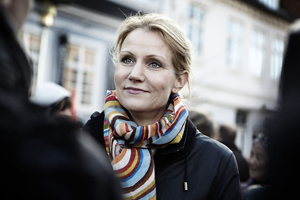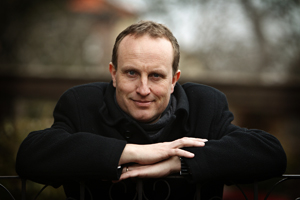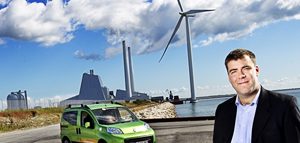Danes decline oil, gas, coal and nuclear
on
Denmark, holder of the next EU Presidency, goes for 100% decarbonisation
Danes decline oil, gas, coal and nuclear
The newly elected Danish centre-left government has set Denmark on a radical decarbonisation course. It has raised the CO2-reduction target from 20 to 40 per cent by 2020 and wants a complete phasing out of all fossil fuel use by 2050. Denmark, poised to take up the EU Presidency in January, already has the highest energy prices in Europe, but the government believes its new ambitious green policies will be good for the economy: they will stimulate green technology with a big potential for jobs and exports.
 |
| The new Danish Prime Minister Helle Thorning-Schmidt (photo: Flickr) |
Electricity prices for households are the most expensive in the EU.
However, this has not deterred the new centre-left coalition government, which took up the reigns of government in October, from raising the decarbonisation bar for the future even higher. Much higher, in fact. In the new energy package, named Our Future Energy – which was presented on 25 November by the new minister for Climate, Energy and Building, Martin Lidegaard, just before he left for the UN Climate Conference in Durban – the government proposes a doubling of the CO2 emission reduction target from 20% to 40% by 2020, a phasing out of coal use in 2030, with no carbon capture and storage (CCS) envisaged, and a complete phasing out of all fossil fuels by 2050. In addition, electricity production from wind power must be increased from 22% now to a whopping 50% in 2020.
Broad political agreement
Living up to these green ideals is going to be far from easy. In 2010 fossil fuels still supplied 79 per cent of gross energy consumption in Denmark, with a share of 21 per cent for gas,18 per cent for coal, 40 per cent for oil. For one thing, the combined heat and power stations that feed hot water into the district heating systems – which in Denmark serve 62 per cent of private households – will gradually have to be converted from coal to biomass, which will necessitate the import of over 1.5 million tons of imported wood pellets annually (e.g. from Russia, Canada and Ghana).
Still, the Danish energy sector seems to be unfazed by the prospect of a carbon-free future. Lars Aagaard, managing director of the Danish Energy Association, which represents the Danish power generation and distribution companies, says of the 50 per cent wind power target: ‘It is extremely ambitious eight years from now, given it has taken 20-30 years to achieve 22 per cent, but it is not impossible’.
The ‘real challenge’, he adds, ‘will be to use the fluctuating electricity in such a way we will get a maximum of benefits from it. We will need to introduce big heat pumps in the district heating system – replacing coal, gas and biomass. We will also need plans for converting individual heating from oil- and gas fired boilers to heat pumps and for using electricity to power cars. And then we will need to have much more capacity in transmission lines to the rest of Europe, including new transmission lines to e.g. the UK.’
Aagaard says he hopes for a broad political agreement on the package, so that a future change of government does not change the incentives for investments. Though having a majority in parliament the
| 'We will need to have much more capacity in transmission lines to the rest of Europe, including new transmission lines to e.g. the UK' |
Creation of jobs
In a first reaction, energy spokesman Lars Christian Lilleholt of the Liberal Party Venstre, which formed a coalition with the Conservatives in the previous government, said the ambitious policy of the new government will be too costly for consumers and damage the competitiveness of the business community.
Still, a compromise will probably be achieved. For a number of years now there has been a tradition of broad agreements on Danish energy policy with a strong emphasis on promoting wind power and CO2-reduction without much concern for the electricity prices paid by households. A compromise deal might lead to a lower wind power target, but offer higher subsidies for biogas and second-generation ethanol (based on straw), which is what the farming industry and green biotechnology companies have been lobbying for. Venstre generally draws strong support from the agricultural sector. At this moment, more than 1 million tons of straw is used annually to fuel power stations, but this can only be burned together with coal. If coal is phased out, that won’t be possible anymore.
According to the government, the proposals will cost DK5.6 billion (€0.75 billion) annually by 2020, in addition to a presumed increase in the price of imported coal and gas during the coming decade. But Lidegaard and the new prime minister HelleThorning-Schmidt of the Social-Democratic Party strongly insist that their policy will stimulate the development of new green technologies, e.g. in smart grids and electric cars, which will lead to the creation of jobs and generate income from exports. The package promises around 5,500 new "green" jobs per year in the coming years, but the government has made no attempt to find out how much of this job creation is the result of substitution (i.e. whether there will be a net increase of jobs).
Lidegaard, a former MP, was working chairman of a green think tank, Concito, which he helped to establish after failing to get reelected to Parliament in 2007. Concito has been lobbying strongly for green investments in wind power, energy savings, and so on, over the past few years.
New green times
Outside observers might think that the costly green policies of the government would lead to strong criticism in Denmark, but that is not the case at all. The Federation of Danish Industry, for instance, like the Danish Energy Association, has welcomed the package – which will benefit part of its membership – although it has warned against raising energy costs further for the industry. In fact, the package includes special measures for highly energy-intensive industries. The prime minister has said that ‘industry and other export enterprises must have time to adjust to the new green times’.
The costs of the package will be paid through the Public Service Obligation (PSO) system, which is basically a tax on electricity which the state-owned Transmission System Operator (TSO) Energinet.dk
| The prime minister has said that 'industry and other export enterprises must have time to adjust to the new green times' |
Among energy experts there is only a handful of individuals who question the coherence of Danish energy policy, but they are not given much space in the public debate. ‘You are not supposed to question the energy policy. If you do so, you get marginalised’, says Paul-Frederik Bach, an independent consultant and blogger on electricity planning who worked as planning director for the systems operator in the west of Denmark for many years. ‘There is a strong group thinking supporting wind power and renewables and the phasing out of fossil fuels. I think this is an offspring of many years of global warming debate in this country.’
Then there is the state-financed so-called Economic Council of Wise Men – four economics professors – who have voiced some criticisms of energy policy, though not so much aimed at the targets as at the methodology. They have argued that it does not make sense to spend money on reducing emissions in industries that are covered by the European Emission Trading Scheme (ETS), as these have to reduce emissions anyway. It makes more sense, they say, to subsidize companies that are not part of the ETS. They have also questioned the relatively large amount of subsidies going to wind power.
Fairy tale of wind turbines
Yet wind power continues to be the mainstay of Danish energy and climate policy in the new package. The export of wind turbines by Vestas and Siemens Wind Power (until 2004 Danish-owned Bonus Energy) and the jobs associated with their production are often referred to in Denmark as ‘the fairy tale of the wind turbines’. The wind industry employs 25,000 people in Denmark, according to the Danish Wind Industry Association, and in 2010 the export of turbines generated over € 6 billion in revenue. At this moment, though, the Danish producers are suffering under Chinese competition. While Siemens, which has the lead in offshore turbines, has increased its staff during this year, Vestas has had to reduce the number of its employees.
 |
| Minister for Climate, Energy and Building Martin Lidegaard (photo: Dresling Jens) |
The new energy package wants an additional 2100 MW of wind power capacity to be built before 2020, of which 500 MW will be land-based, 400 MW near offshore and 1200 far offshore. This is in addition to the 800 MW of new offshore wind capacity that has already been commissioned and should be on line in 2013.
A major part of the expansion will thus be made offshore. This is mostly because onshore wind turbines are increasingly meeting with NIMBY-resistance in Denmark – especially now that the new generation of wind turbines reach heights of up to 150 metres and emit disturbing low frequency noise. In the past, residents were often persuaded to lend their consent to the construction of turbines by being offered guaranteed power prices or a chance to invest in the project, but these incentives are apparently not sufficient anymore. The number of local civic groups that oppose wind power projects has grown from 40 to 125 during the past year, according to the National Association of Civic Groups against Wind Turbines. In addition, earlier this year a new test centre for giant wind turbines which is being built in Northern Jutland, and for which woods had to be cut down, drew a lot of protest from conservationists and others.
New interconnections
The high and increasing share of wind is not without its problems.When production exceeds demand in the Danish system today, electricity is exported at whatever price can be achieved, which is sometimes close to zero or even at a negative price in the Nord Pool system. In those cases the Danish consumer, who has to pay a guaranteed price through the PSO charge, subsidizes consumers in other countries.
The PSO-supported guaranteed price is not fixed, but to give an indication: Dong Energy was granted a price of DK 1.051 (€0.14) per kWh for its 400 MW Anholt offshore park in the Kattegat (between Denmark
| The number of local civic groups that oppose wind power projects has grown from 40 to 125 during the past year |
However, now that Danish power production will be greatly expanded, the need to export power at certain times will become even greater. This means that the capacity of transmission lines to Norway, Sweden and Germany will have to be greatly increased. Lars Aagaard of The Danish Energy Association would like to see new interconnections being built to the Netherlands and the UK as well.
The need to export wind power is especially great during the winter months, when wind power production is much higher on average than in the summer. In Denmark, this is also the time when the CHP (combined heat and power) stations need to supply the people with heating and thereby also produce electricity. This means that there will be times with a large overcapacity.
This is already the case now. During the first three (winter)months this year, Denmark exported 1715 MW to Norway and Sweden, and imported only 25 MW from the same countries. In the summer, when wind power production is lower and the Danish CHP stations produce less heat (and thereby electricity), the situation is reversed.
Fortunately, when this happens, Norway and Sweden can usually provide Denmark (and Germany and the Netherlands) with flexible balancing power, thanks to their large hydropower production capacity (except when the Scandinavian water reservoirs are low, which also happens sometimes). Problem is, Norway and Sweden (not to mention Germany) also have plans to greatly expand their power capacity, so they may need their hydropower for themselves in the future.
Ecogrid
 |
| Lars Aagaard, managing director of the Danish Energy Association (photo: Dansk Energi) |
In the longer run, the Danes hope that the intermittency problem of wind energy can be solved with a smart grid, in which electric cars will also be integrated as well as an increasing number of heat pumps that are to replace oil- and gas-fired furnaces for heating in individual homes outside the district-heated areas.
Lidegaard, the new Minister, has promised to come up with a strategy for establishing such a grid. In October the Smart Grid Network, a group with representatives from research institutions and energy companies, published a number of recommendations for a smart grid strategy.
Earlier this year in the Danish island of Bornholm a large, four-year pilot project was started to test the possibilities and limitations of a Smart Grid system. Organisations from ten countries participate in this partially EU-funded project, called Ecogrid EU. The 2,000 households that are taking part in the pilot will have to show, by their behavior, whether the Danish green dreams can become reality.
|
Energy priorities for the Danish EU Presidency As of January 1st Denmark will take over the rotating EU Presidency. In the energy and climate field, Denmark will vigorously promote the adoption of the EU Energy Efficiency Directive. It will also try to limit the amount of CO2 quotas in the European Emission Trading Scheme (ETS), thereby hoping to raise the price of CO2 emission permits. The Danish presidency will also work with the Commission to promote the 2050 Climate Road Map and the 2050 Energy Road Map. |
|
Danish energy facts and figures Power production 2010 |
|
Intermittency of Danish wind power The Danish Ministry of Taxation – responsible for collecting levies on electricity - in a recent report (Redegørelse for mulighederogvirkningerafændredeafgifterpåelectricitet, only available in Danish) described the size of the fluctuation of wind power production. The analysis is based on the period 2007-2008 in West Denmark, where most wind turbines are placed, including a number of offshore ones. |
|
About the author Frede Vestergaard is senior economics and energy reporter with the weekly Weekendavisen, Copenhagen. |


Discussion (0 comments)